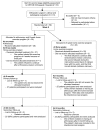Knee arthroscopy and exercise versus exercise only for chronic patellofemoral pain syndrome: a randomized controlled trial
- PMID: 18078506
- PMCID: PMC2249589
- DOI: 10.1186/1741-7015-5-38
Knee arthroscopy and exercise versus exercise only for chronic patellofemoral pain syndrome: a randomized controlled trial
Abstract
Background: Arthroscopy is often used to treat patients with chronic patellofemoral pain syndrome (PFPS). As there is a lack of evidence, we conducted a randomized controlled trial to study the efficacy of arthroscopy in patients with chronic PFPS.
Methods: A total of 56 patients with chronic PFPS were randomized into two treatment groups: an arthroscopy group (N = 28), treated with knee arthroscopy and an 8-week home exercise program, and a control group (N = 28), treated with the 8-week home exercise program only. The arthroscopy included finding-specific surgical procedures according to current recommendations. The primary outcome was the Kujala score on patellofemoral pain and function at 9 months following randomization. Secondary outcomes were visual analog scales (VASs) to assess activity-related symptoms. We also estimated the direct healthcare costs.
Results: Both groups showed marked improvement during the follow-up. The mean improvement in the Kujala score was 12.9 (95% confidence interval (CI) 8.2-17.6) in the arthroscopy group and 11.4 (95% CI 6.9-15.8) in the control group. However, there was no difference between the groups in mean improvement in the Kujala score (group difference 1.1 (95% CI -7.4 - 5.2)) or in any of the VAS scores. Total direct healthcare costs in the arthroscopy group were estimated to exceed on average those of the control group by euro901 per patient (p < 0.001).
Conclusion: In this controlled trial involving patients with chronic PFPS, the outcome when arthroscopy was used in addition to a home exercise program was no better than when the home exercise program was used alone.
Trial registration: Current Controlled Trials ISRCTN 41800323.
References
-
- Ficat R, Hungerford D. Disorders of the patello-femoral joint. Paris: Masson; 1977.
-
- Post WR. Anterior knee pain: diagnosis and treatment. J Am Acad Orthop Surg. 2005;13:534–543. - PubMed
-
- Fulkerson JP. Diagnosis and treatment of patients with patellofemoral pain. Am J Sports Med. 2002;30:447–456. - PubMed
-
- Heintjes E, Berger MY, Bierma-Zeinstra SM, Bernsen RM, Verhaar JA, Koes BW. Exercise therapy for patellofemoral pain syndrome. Cochrane Database Syst Rev. 2003:CD003472. - PubMed
-
- O'Neill DB. Open lateral retinacular lengthening compared with arthroscopic release. A prospective, randomized outcome study. J Bone Joint Surg Am. 1997;79:1759–1769. - PubMed
Publication types
MeSH terms
Associated data
LinkOut - more resources
Full Text Sources
Medical
Research Materials


